by Linda Venn
Click here for a list of key characters in this story
The evidence given by Constable Rynne, Monday 28th December
Constable Rynne was now called to give evidence. He had arrived at Mt Spec Road about 4pm on the day of the hold-up, meeting up with “a number of men, and they made an investigation of the surroundings.” Rynne saw the log (about 15 feet long) and the pile of bushes on the left hand side going up the road. He “also found on two trees marks made by pellets from a gun, and found a pellet embedded in a tree on the right hand side looking at Mt Spec, and about three feet from the road and about 18 yards from the clump of bushes.” With Acting Sergeant McDonald and a tracker, Rynne conducted a search of the area for footprints. The tracker showed him hoof marks and also “barely distinct footprints of a size 7 or 8 boot” in a gully about 130 yards away. There were “a number of hoof marks there but rain which had come down the gully and partly obliterated them”. Rynne believed the tracks to be new. As with Gooch, Roberts challenged Rynne on his competency to conclude this; “he was not an expert to say so”, and besides, “the rain had covered them.”
Rynne continued. He stated that there were “two distinct tracks going out of the gully which he followed along the side of the mountain to Tealby’s fence and up the side of the mountain for about a chain.” Rynne estimated the length of tracks followed to be approximately half a mile. The tracks “appeared to have been freshly made, and made by a horse travelling at a fairly fast gallop.” The rain fell after these tracks had been made. Rynne then went back to the crime scene, where he met up with the police from Townsville.
The next day, the police again looked for the tracks, but now found that sections were under water. Rynne found some tracks similar to those he had found the previous afternoon, and these were also followed for about a quarter of a mile in the direction of Tealby’s yard. Rynne later went to Tealby’s yard, where Gooch showed him the chestnut mare. The mare was led through the yard, and Rynne thought “the tracks appeared similar to those he had followed from the gully. He formed the conclusions that the tracks found on the previous day were those of the chestnut mare.” However, when a comparison was made with the tracks in the gully, Edmonds had said they were not of the mare’s. Edmonds picked up the tracks about a chain from Tealby’s gate and followed them to within six feet of the gate. At the gate, “Detective Gooch told defendant that the tracker considered the tracks were made by the chestnut mare, and that he must have come down the track, but defendant stated he had come down the track from the direction of his hut”, adding “he would not pull a gun on a man for a few pounds.” Edmonds lived about a mile and a quarter from Tealby’s, but Tealby’s was admittedly closer to the scene of the hold-up. At this point, Roberts requested that Rynne prepare “a plan of the country he traversed from the scene of the hold-up”, in readiness for Tuesday morning’s session. The court then adjourned until 11 o’clock the next day.
Rynne continued giving evidence on Tuesday morning (Townsville Daily Bulletin, Wednesday 30th December 1931, p. 11). He stated that O’Brien was not the first person he met at the scene of the hold-up. “There were a number of civilians there, the majority of whom had guns. He did not know there were other men searching the district. The country was rather thickly timbered.” Rynne first met Edmonds the next day [Thursday] at Tealby’s yard, then at Edmonds’ hut on the Friday, and again on Sunday. On Sunday, in company with O’Brien and the tracker, they obtained a statement from Tier. Rynne confirmed that Edmonds referred “to other tracks, alleging they were not the tracks of his mare.” Rynne stated he was not equipped to take plaster casts of the tracks or any sample of them “owing to the nature of the ground.” Rynne agreed “it would have been very material for the prosecution if he had been able to take the tracks in the soil.” However, Rynne did not hear Gooch point out to Edmonds “another place where a horse had been tied up.” Rynne recalled only one gap in the tracks, of about 150 yards, and did not know what Gooch meant when he said they “followed the tracks intermittently.” Rynne had not told Edmonds he had followed the tracks all around the yard the previous afternoon and “had lost them.” Rynne did not agree with Edmonds’ suggestion “that horses had been galloping all over the country.” Rynne was “quite satisfied that the tracks they followed on December 10, with defendant were the tracks witness [Rynne] had followed the previous day.” Where the tracks were lost, they were leading to Edmonds’ hut, so they had searched in a circle of between 150 and 300 yards. Edmonds denied the tracks were of his horse. At Edmonds’ request, Rynne had measured some tracks near Tealby’s. He had not told Edmonds these tracks were not those of the mare.
Rynne was present at the dress rehearsal, “but he did not hear Detective Gooch say to Constable O’Brien that they would dress defendant up.” Rynne saw Edmonds shake hands with O’Brien and heard him tell O’Brien “he was making a mistake, as he would not hold a cobber up for the pay.” O’Brien has replied “he would be the sorriest man in the world if he were making a mistake.” Rynne saw no more of Edmonds, as he had then gone on to the Main Roads camp.
Rynne was questioned about the tracks by both Roberts and the police prosecutor, Sub-Inspector Blackmore. Rynne confirmed that the tracks from the scene of the hold-up did not go directly to Tealby’s, but took about a mile to cover. Blackmore endeavoured to establish that only one horse, not two, and therefore only one man, not two, had been involved in the hold-up. Rynne had seen “nothing to indicate that more than one horse had been tied up in the gully, or that one horse had been tied up in two places, nor did he find indications that more than one horse had been ridden out of the gully, or that a horse had been ridden down into the gully.”

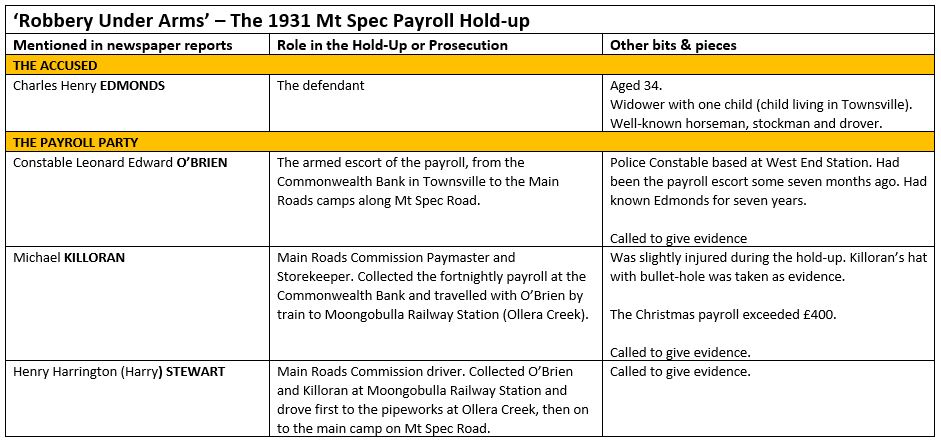
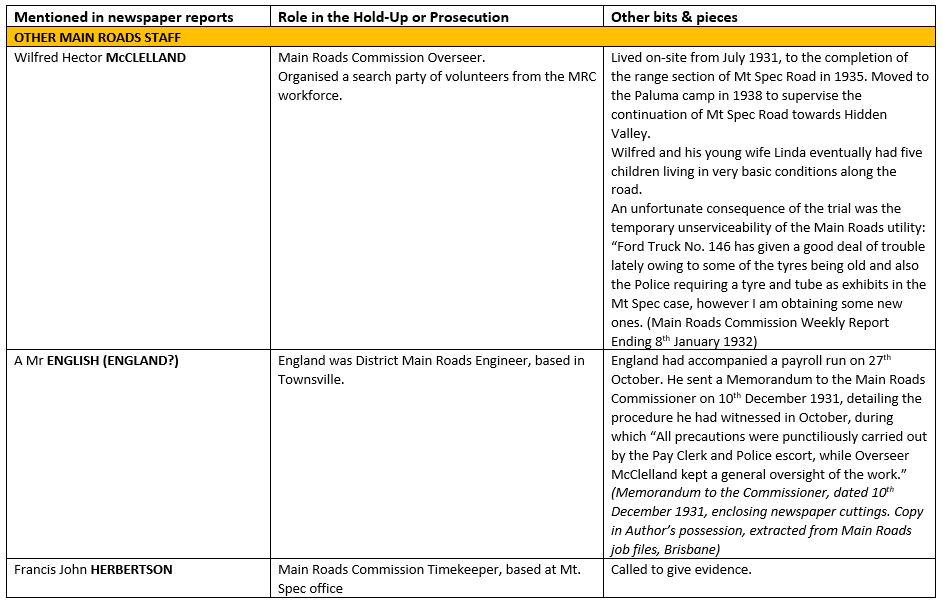



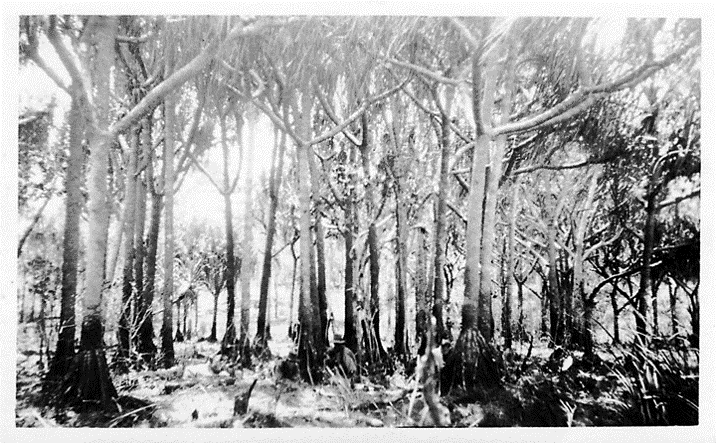
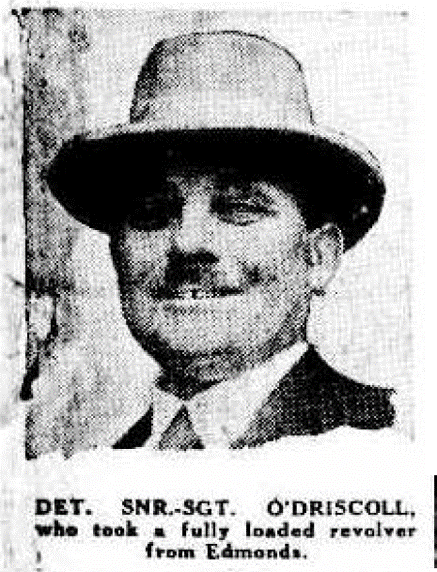
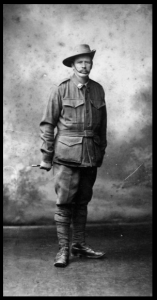
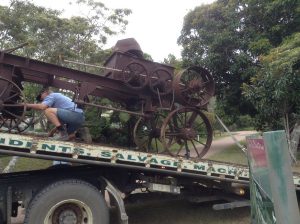 On Friday 12th October, two new arrivals appeared on the lawns adjoining Lennox Crescent and Mount Spec Road. They emerged from a dense cloud mist which enveloped Paluma that day, like visitors from the mists of time. The ambience seemed fitting, as these new arrivals are relics of a bygone era; a timber hauler, which was used to haul timber on Mt Spec and a bitumen mixer used in surfacing the Range Road during the 1950’s. The large, solid steel machines are well preserved and represent the epitome of engineering design and workmanship of their day.
On Friday 12th October, two new arrivals appeared on the lawns adjoining Lennox Crescent and Mount Spec Road. They emerged from a dense cloud mist which enveloped Paluma that day, like visitors from the mists of time. The ambience seemed fitting, as these new arrivals are relics of a bygone era; a timber hauler, which was used to haul timber on Mt Spec and a bitumen mixer used in surfacing the Range Road during the 1950’s. The large, solid steel machines are well preserved and represent the epitome of engineering design and workmanship of their day.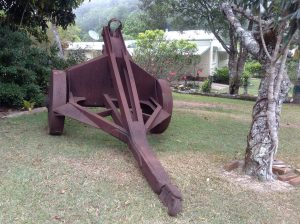 towed behind a small bulldozer. A steel rope from the winch on the dozer ran over the pulley on the bob-tail. By retracting the winch rope the heavy end of the log would be lifted off the ground and dragged out of the scrub to the loading ramps. The logs would then be loaded onto trucks towing timber jinkers for transport to saw mills or the rail siding at Moongobulla.
towed behind a small bulldozer. A steel rope from the winch on the dozer ran over the pulley on the bob-tail. By retracting the winch rope the heavy end of the log would be lifted off the ground and dragged out of the scrub to the loading ramps. The logs would then be loaded onto trucks towing timber jinkers for transport to saw mills or the rail siding at Moongobulla.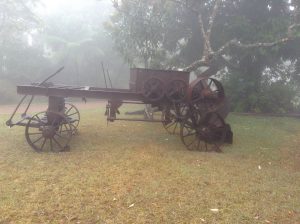 Until then the road was unsealed. The bitumen mixer carried a drum that had two sets of paddles running through it which mixed the liquid hot tar with sand and gravel to produce bitumen for sealing the road. Unfortunately the engine driving the mixer via two leather belts, is missing. Possibly it was a Southern Cross engine, one of which may eventually be obtained and set in place.
Until then the road was unsealed. The bitumen mixer carried a drum that had two sets of paddles running through it which mixed the liquid hot tar with sand and gravel to produce bitumen for sealing the road. Unfortunately the engine driving the mixer via two leather belts, is missing. Possibly it was a Southern Cross engine, one of which may eventually be obtained and set in place.